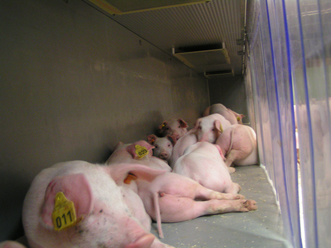Context
Wallonia’s pig industry presents several paradoxes. Pork is the principal meat consumed, accounting for more than 50% of total meat consumption. However, the region’s pig population represents only around 6% of the national total and Wallonia’s pigmeat production currently meets only 25% of the region’s consumption.One main reason for this low level of production is the ‘not in my back yard’ attitude of consumers with regard to pig farms, whereas those same consumers admit the need for the primary sector and are concerned about the sustainability of the agricultural system.Objectives
The aim of the project is to experiment with a new design of post-weaning and farrowing pens planned with attention to the animal welfare aspect and the sustainability of the farming system. The object is to provide pig farmers with a new frame of reference within this context.A further aim is to try to overcome the lack of farrowing units in Wallonia by exploring models likely to be socially acceptable.Description of tasks
This is a two-stage project: 1. Experiments with post-weaning and farrowing pens with piglet creep area.Environmental issues are becoming increasingly important. Consumers tend to see an obvious link between traditional pig rearing in slurry and environmental and landscape impacts, and this link may also involve the animal welfare issue. An innovative approach is called for here which is both consistent and quality-oriented, by bringing together this set of quality concerns which are all too often separate or disregarded. The intention is therefore to test a new design of well thought-out litter-type post-weaning and farrowing pens from the point of view of technical feasibility, animal welfare and ease of use by the farmer. The objective is to boost social acceptance of pig farms and enable farrowing units (the least profitable link in the chain) to benefit from added commercial value in order to optimise the return on their labour. a) Post-weaning pensThe post-weaning pens are of the litter type, with a limited grated area (defecation area) and a heated “withdrawal” area for piglets.The experiments comprise:- Animal production and energy consumption measurements,- Rating of physical injuries (scratches/bites/grazes) with specific scoring for tails, ears and position of legs,- Space occupancy and cleanliness, - Reactions to human beings and behavioural observations. b) Farrowing pensThe pens have a suckling area on litter and a defecation area. Each pen has a heated shelter where the piglets can rest in isolation. The pens offer the sow considerable freedom of movement.Measurements concern:- Practicality and ease of use for the farmer and the installation cost,- Sow and piglet behavioural measurements:o sow suckling process and sequences,o space occupancy by the sow and by the piglets,o scoring of sow activity while nursing the piglets,o piglets’ emotional reactions.- Animal production parameters. 2. Final report and transfer of resultsResults will be transferred by agreement with the Development and Extension Section of the Department of Agriculture. The final report will comprise the experimental results and the assessments made.Contribution
Project leaderPartners
Université de Liège, Faculté de Médecine Vétérinaire, Département des Productions animales, Boulevard de Colonster, 20 B43, 4000 Liège.
CRAW off coordinator
J. Wavreille, attaché scientifiqueRue de Liroux, 85030 GemblouxTél. : +32 (0)81 62 67 70Fax : +32 (0)81 61 58 68Email : prodanim@cra.wallonie.be
Funding
- DGARNE



